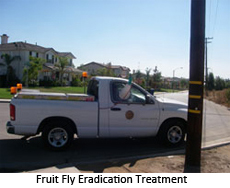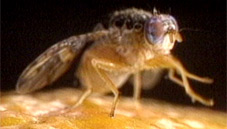Guava Fruit Fly Project

Guava Fruit Fly (Bactrocera correcta) is an invasive pest that is not established in the continental United States. The California Department of Food and Agriculture (CDFA) conducts eradication projects when evidence of an infestation is found within the State. The purpose of an eradication project is to prevent the environmental and economic damage that would be caused by the establishment of this pest. Establishment of this fly would cause direct economic losses via damaged fruit, increased pesticide use statewide by commercial and residential growers in efforts to lessen this damage, loss of revenue due to export restrictions on fruit both domestically and internationally, and adverse impacts on native plants through the destruction of their fruit. Yearly economic losses would be in the hundreds of millions of dollars.
The eradication treatment, known as the male attractant technique (MAT), is conducted in an area defined by a 1.5 mile radius from each fly find site, for a minimum of 9 square miles. Approximately 600 small gel-like "bait stations" per square mile are applied to the sides of individual utility poles and street trees on public right-of-ways. These bait stations contain a powerful male attractant (methyl eugenol) that is mixed with a small amount of the pesticide spinosad. The bait station will attract and kill male fruit flies before they can breed. In the absence of males, the females go unmated and no offspring are produced, effectively causing the extinction of the population within two life cycles. The attractant is very specific for this group of flies, so much so that other insects such as bees or butterflies will not be harmed because they are not attracted to the lure.
The bait stations are applied to utility poles and street trees by trained CDFA staff in specially modified pick-up trucks. The stations are applied at least 6 feet above ground, well above the reach of children or pets. Bait stations are not applied on school grounds. Applications are repeated every two weeks for up to two life cycles. The fly’s development is dependent on temperature, and it is sped up during warmer temperatures and slowed during cooler periods. Most treatment programs are complete after a 2-3 month period, but those beginning in the fall may extend into the following spring because of the cooler winter temperatures. Following two life cycles of treatment, supplemental fruit fly traps are monitored for an additional life cycle. If no additional guava fruit flies are trapped, the infestation is declared eradicated.
General Information
Treatment Area
- None at this time
Quarantine
CDFA YouTube
Spinosad: Organic Pest Treatment for Invasive Fruit Flies
CDFA staff use an organic treatment to help protect California agriculture from invasive fruit fly infestations.. (3:21) Transcriptof Spinosad: Organic Pest Treatment for Invasive Fruit Flies Video

